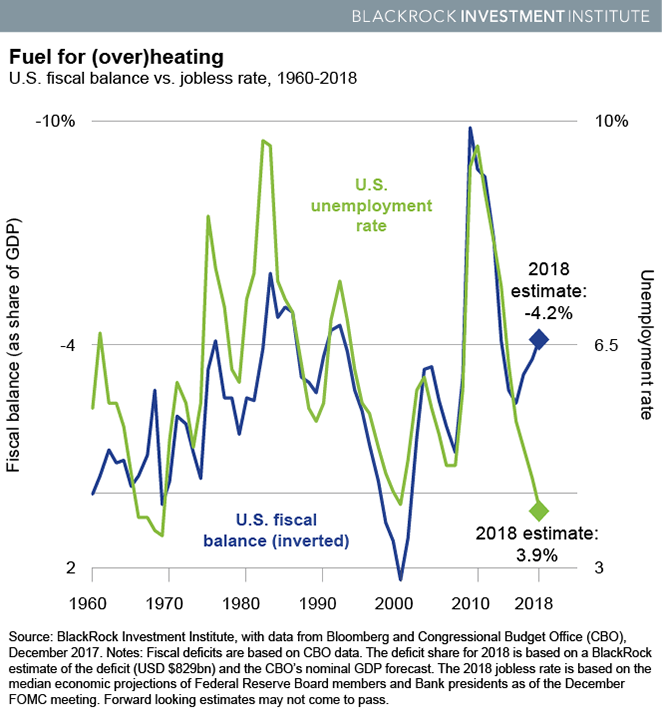From BlackRock: Jeff Rosenberg shares four narratives likely to shape fixed income investing this year.
We see four key themes likely to shape fixed income investing in 2018, as I write in my new Fixed income strategy Fuel for (over)heating and more of my favorite themes.
Fuel For (over)heating
Fiscal stimulus from tax cuts and spending plans–on top of a U.S. economy operating at full employment and both the U.S. and a handful of other developed economies operating above capacity–may provide fuel for an overheating debate in 2018. The Fuel for (over)heating chart below highlights the unusual nature of expanding fiscal support at this stage of the economic cycle: The fiscal deficit is set to widen even as the unemployment rate touches multi-decade lows.

What are your expectations for the fixed income market in 2018? Join in >
Our 2018 Global Investment Outlook sees stable growth with ample room to run. U.S. fiscal plans, however, point to significant upside potential in consensus growth forecasts for 2018, we believe. Key for fixed income investors is the contribution this may make to inflation’s comeback–supportive of ongoing policy normalization, higher nominal rates and better relative performance of inflation-protected securities. We believe the Federal Reserve (Fed) would likely delay any pre-emptive action, keeping to a moderate pace of rate hikes in 2018. But an inflation acceleration could finally result in an increasing inflation risk premium. This supports our investment views, including a preference for shorter-maturity and inflation-linked bonds.
Overall this theme, our top one for 2018, implies upside growth and inflation potential, with equities the main beneficiary and bonds playing a key diversification role. Our fixed income asset views for 2018 center on strategies to limit the costs in a rising-rate environment of providing diversification for broad portfolios. This means an up-in-quality stance, with bonds serving as portfolio shock absorbers and equities the primary focus of risk taking.
Ahead Of The Curve
Global yield curves flattened in 2017, but we see several reasons for this trend to halt–and perhaps even to reverse in 2018. Factors that have caused excess demand relative to supply in longer-maturity bonds appear to be shifting. Among them, central banks are pulling back on their degree of support just as fiscal stimulus implies rising issuance. Yet considerable global savings may limit both the extent of any curve steepening and the degree of increases in rates.
Upside risks to growth may fuel rising inflation expectations, which should also manifest themselves in steeper long-end curves. This improves the outlook for the front end, floating rate instruments and Treasury inflation-protected securities (TIPS) and leads us to favor shorter-maturity rate exposure over the long end to start 2018. Compressed valuations in agency mortgage-backed securities and the tail risk from the uncertain impact of Fed balance sheet normalization keep us neutral on the asset class.
Late-Cycle Blues
Sustained global expansion with inflation slowly moving back toward trend provides a positive backdrop for credit in the form of low default rates and stable default expectations. But credit valuations reflect dynamics of low defaults and low uncertainty along with rising leverage and increased issuer friendliness. This is evidenced by tight spreads across both high yield and investment grade. Credit spreads have historically tightened through economic expansions. Once the cycle matures and economic spare capacity has been used up, they tend to trough, our analysis of past cycles shows. This implies less upside potential at this stage of the cycle, with U.S. gross domestic product performing above potential.
An extended cycle with room to run means investors may expect coupon income but with lower total returns than in recent years. Spreads are compressed both in absolute terms and across the quality spectrum, underscoring our preference for up-in-quality exposures. Overall we see credit primarily as a source of income, with limited potential for price appreciation from spread compression.
Emerging Challenges
Our broad asset class views favor emerging market (EM) equity over EM debt (EMD). This partly reflects tight hard-currency debt spreads, which curb the upside given limited scope for further spread compression–and creates a vulnerability to any rapid rate moves. Yet our base case of gradual Fed rate increases looks favorable for EMD, which remains a favored fixed income sector in a world of exceptionally low developed market rates. Local-currency debt appears well supported in an environment of low currency volatility.
However, the outlook appears increasingly challenged as more EM central banks move to tighten policy. Risks to our view include an “overheating” state where faster increases in U.S. rates lead to a quicker shift toward tightening by EM central banks, along with higher local yields. EM policy is already undergoing a sea change from 2017. Then, six of the 18 central banks we analyzed were easing, with only three hiking. We see five easing and 11 increasing rates in 2018. Tighter policy prospects reduce our return expectations relative to 2017. Read more market insights in my Fixed income strategy.
Jeffrey Rosenberg, Managing Director, is BlackRock’s Chief Investment Strategist for Fixed Income, and a regular contributor to The Blog.
The iShares Barclays Aggregate Bond Fund (NYSE:AGG) fell $0.08 (-0.07%) in premarket trading Monday. Year-to-date, AGG has declined -1.13%, versus a 5.07% rise in the benchmark S&P 500 index during the same period.
AGG currently has an ETF Daily News SMART Grade of B (Buy), and is ranked #5 of 36 ETFs in the Intermediate-Term Bond ETFs category.
This article is brought to you courtesy of BlackRock.
